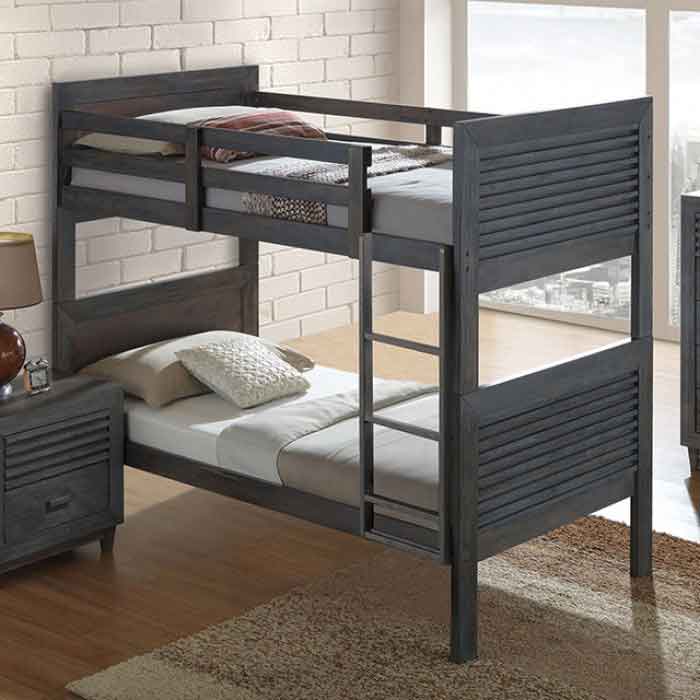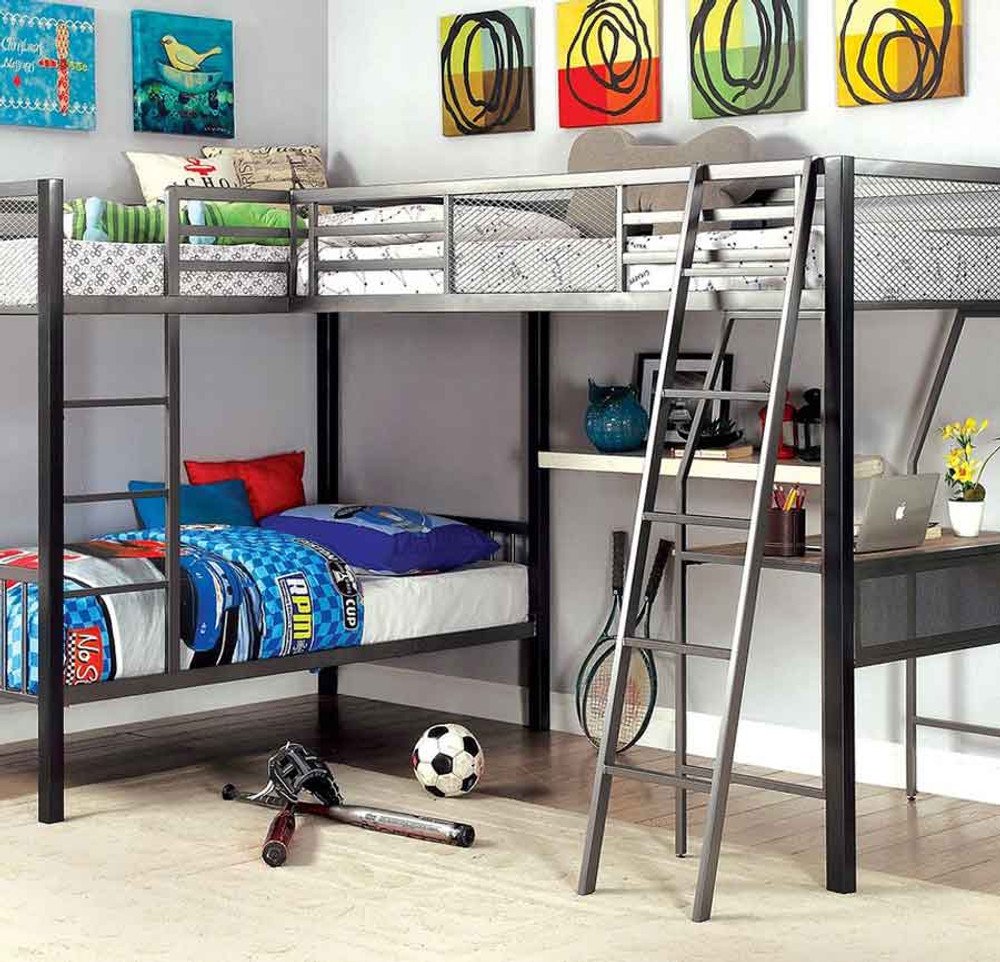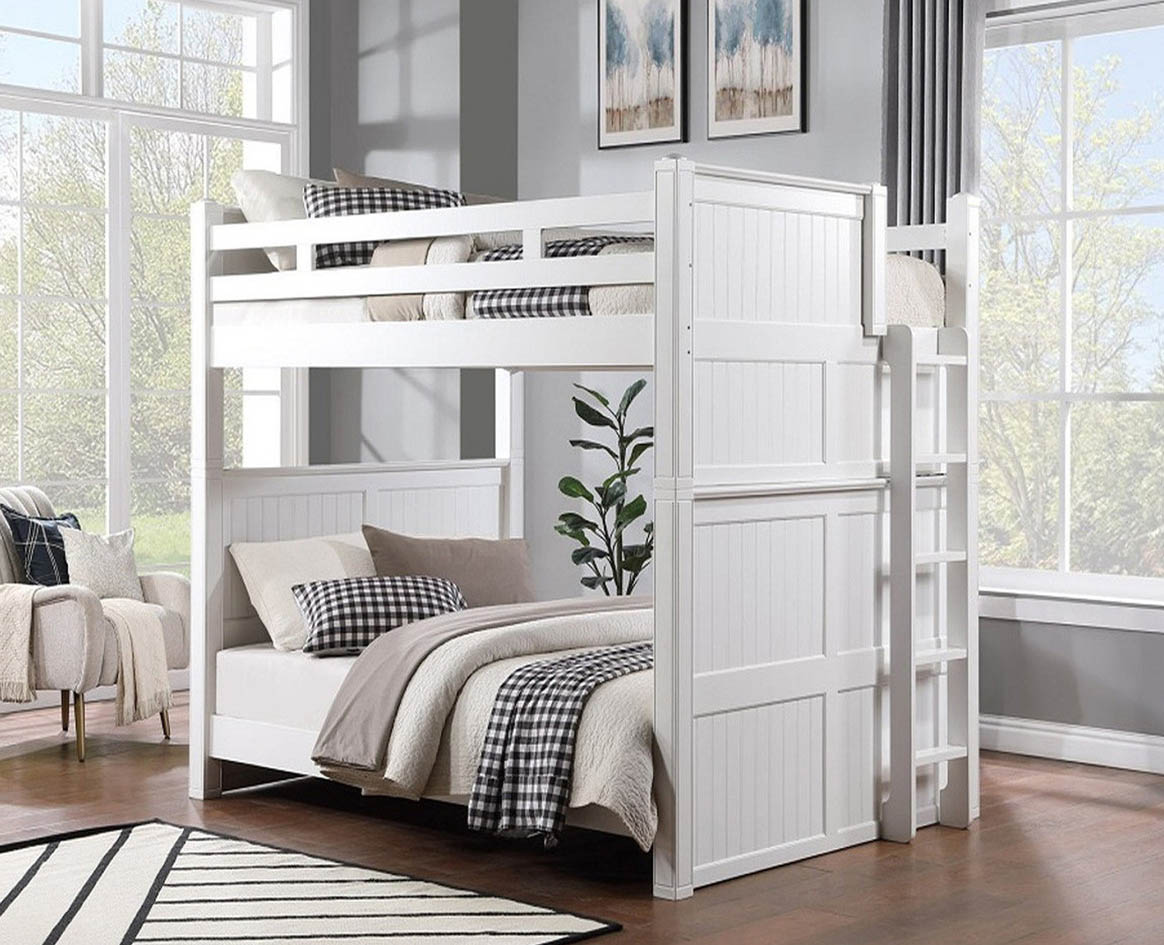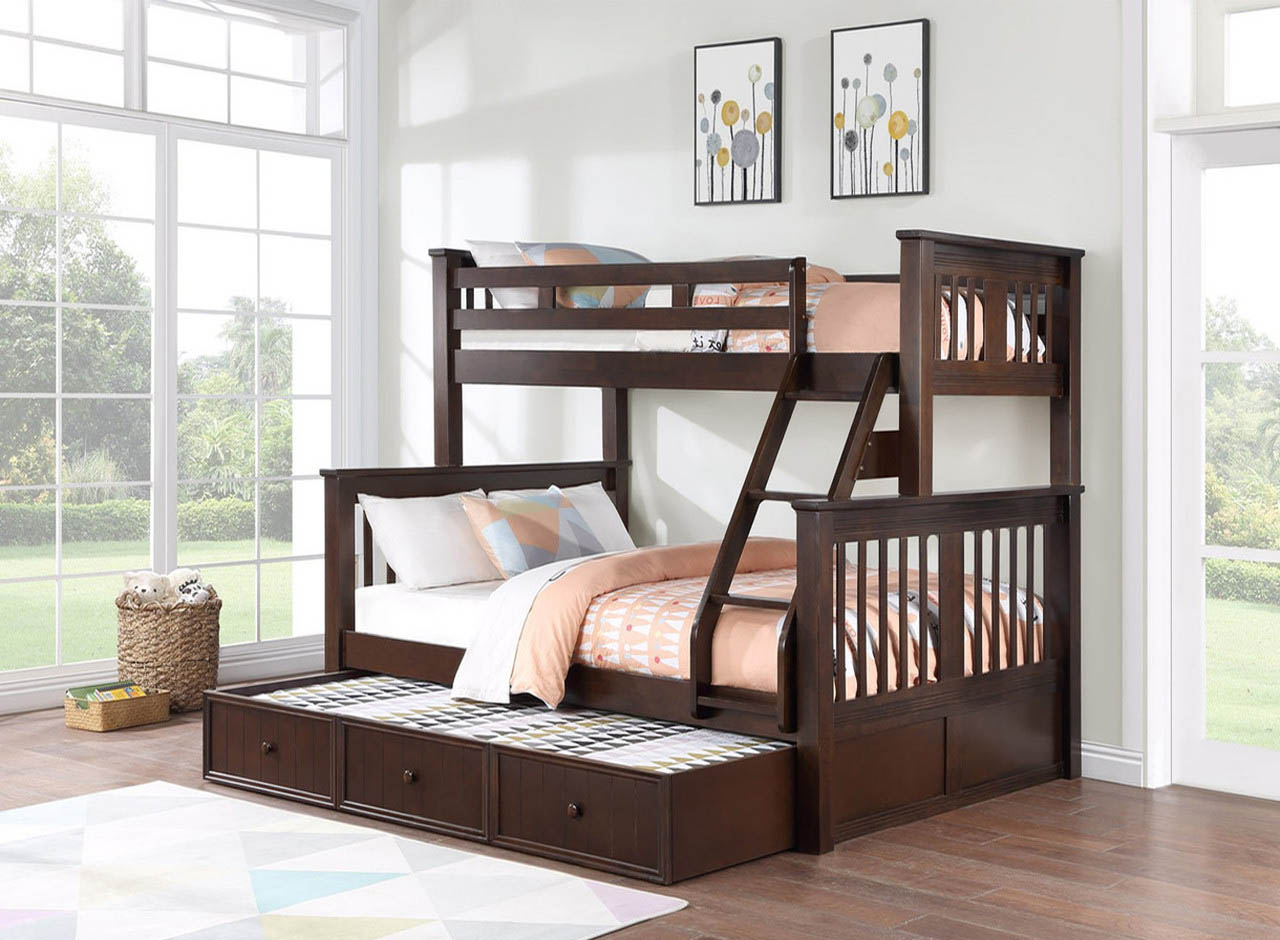Bunk Bed Ladders: Safety Features and Practical Designs
Posted by UPW on Oct 29th 2024
Bunk bed ladders play a pivotal role in ensuring both the functionality and safety of these space-saving sleeping arrangements. Beyond providing access to the top bunk, the design and features of a ladder can impact the user’s experience, from children’s bedrooms to guest accommodations. This blog delves into the essential aspects of bunk bed ladders, emphasizing their safety features and practical design elements to guide readers toward the most suitable ladder option.
The Importance of Ladder Safety in Bunk Bed Design
Ladder safety is a critical aspect of bunk bed design, impacting the well-being of users and the practicality of the furniture. Ensuring a ladder is built to meet safety regulations is essential to prevent accidents, especially for children.

Compliance with strict standards and integrating safety features help mitigate common risks such as slips, falls, and entrapment. Whether used in homes, hostels, or rental properties, a safe ladder design ensures long-term usability and peace of mind for both children and adults.
- Guardrail Integration: Bunk beds with ladders must include guardrails along the upper bunk to prevent falls. Ladder entry points require specific guardrail gaps, typically no wider than 3.5 inches, to prevent accidental entrapment or unsafe access.
- Ladder Placement and Clearance Guidelines: Regulations ensure ladders are installed with proper angles and spacing to make climbing safe and intuitive. A ladder that is too steep may cause users to lose balance, while insufficient clearance between rungs can lead to slips. These standards help create a stable and comfortable ascent and descent, especially for younger users.
- Height and Step Spacing Requirements: CPSC guidelines dictate that steps must be evenly spaced, typically between 7 to 12 inches apart, to ensure consistent footing. This is particularly important for children, as uneven spacing can increase the risk of falls.
- Structural Integrity Inspections: Many safety standards require routine testing of the ladder's hardware and joints to prevent loosening over time. Regular inspections are essential to identify wear and ensure continued compliance with safety standards.
These regulations are essential for safeguarding both children and adults. Ladders used in adult bunk beds must meet the same rigorous standards, as they are expected to support greater weight and withstand frequent use. A bunk bed ladder designed with adherence to these guidelines not only provides secure access but also fosters trust, knowing it is built to handle the demands of everyday use.
Common Safety Features
Bunk bed ladders incorporate various safety elements to make climbing secure and comfortable. Each feature is specifically designed to address common safety risks, ensuring the ladder meets the practical needs of daily use.
- Anti-Slip Steps: Rungs often feature non-slip coatings, textured surfaces or grooved steps that improve grip. These are especially helpful for younger users or during low-light conditions when slips are more likely to occur.
- Side Rails or Hand Grips: Many ladders include integrated rails to help stabilize users during ascent or descent. This feature is essential for young children or adults who may require additional support.
- Even and Consistent Step Spacing: Proper spacing between rungs ensures that climbers maintain rhythm and balance, reducing the chance of missteps. This feature also prevents children from skipping steps, which could lead to falls.
- Rounded Edges and Smooth Surfaces: Steps and ladder frames with rounded edges eliminate sharp corners, minimizing the risk of injury from bumps or accidental contact. Smooth, sanded surfaces also reduce the likelihood of splinters in wooden ladders.
- Secure Fastening to the Bed Frame: Whether fixed or removable, ladders must be securely attached to prevent any wobbling or movement. Fixed ladders are often bolted into the bed frame, providing a permanent, stable attachment point for safe climbing.
These safety features are designed to work together, ensuring the ladder remains practical and secure for everyday use. By focusing on critical aspects such as stability, grip, and ergonomic design, these elements contribute to the overall functionality of the ladder, preventing injuries and ensuring ease of use for people of all ages.

Choosing the Right Ladder Material for Durability and Aesthetics
When deciding between wood and metal ladders, it is important to assess the environment in which the bunk bed will be used and the level of durability required. Both materials offer specific advantages, from tactile experience to structural reliability, making them suited for different applications.
Wood vs. Metal Ladders
Wooden ladders provide a natural, tactile surface that feels warmer underfoot and is less likely to cause discomfort during colder months. They work well in residential settings, especially in traditional or rustic bedrooms, where their organic textures and wood grain patterns complement the decor. High-quality hardwood ladders are notably durable but must be handled carefully to avoid dents and scratches from rough use.
On the other hand, metal ladders excel in high-traffic environments where structural strength is prioritized. Built from robust materials like steel or aluminum, these ladders are highly resistant to warping, cracking, or denting, making them ideal for settings like hostels, dormitories, and rental properties.
Metal ladders typically require minimal maintenance, only needing occasional cleaning to remove dust or grime. However, without proper coatings or padding, metal surfaces can feel cold to the touch and may become slippery, especially if used barefoot. Some models address this issue with rubberized steps or textured rungs to enhance grip and safety.
Impact on Overall Bunk Bed Design
The ladder material influences not just the durability of the bunk bed but also how well it integrates into the room's aesthetic. Wooden ladders create a cohesive look with traditional bunk bed styles, such as farmhouse, mission, or cottage-themed designs, where their natural grain and finishes like oak or walnut provide warmth and visual continuity. These ladders tend to emphasize a handcrafted, inviting feel, making them particularly suited for children’s rooms, guest bedrooms, and vacation homes.
Metal ladders, by contrast, contribute to a modern or industrial ambiance, aligning seamlessly with minimalist or urban interiors. Their sleek lines and metallic surfaces bring a clean, no-frills appeal, making them ideal for contemporary spaces, such as loft apartments or rental properties.
Additionally, metal ladders are often more compact, fitting efficiently into smaller rooms where practicality is paramount. The choice between wood and metal, therefore, extends beyond functionality—it defines the tone of the space and supports the overall use case for the bed.
Innovative Ladder Designs for Enhanced Usability
Modern bunk bed ladders are designed to enhance usability, adapting to different layouts and user needs beyond simple access to the top bunk. Choosing the right ladder configuration ensures safe, practical, and efficient use of the bed in any setting.
Angled Ladders
With a sloped design, like the Gary Detachable Full Size Bunk Bed, angled ladders make climbing easier, especially for children or individuals with limited mobility. The incline allows users to place their entire foot on each step, improving balance and reducing strain during ascent and descent.
Integrated Ladders
Built directly into the bed frame, integrated ladders provide constant, secure access while eliminating the need for additional hardware. They save space and prevent movement or detachment during use, making them ideal for compact rooms.
Corner Ladders
Placed at the end or corner of the bed, these ladders offer unobstructed access without interfering with other bed elements. Corner ladders leave space beneath the bed available for storage or other features, maximizing overall room efficiency.
Removable Ladders
Offering flexibility, removable ladders can be detached when not needed, making them practical for guest rooms or adaptable spaces. However, frequent removal may wear down attachment points, so they work best in low-traffic settings.
Fixed Ladders
Permanently attached to the bed, fixed ladders provide stable, wobble-free access. Many models include built-in storage, such as drawers within the steps, adding functionality. Fixed ladders are ideal for permanent installations, ensuring long-term stability and a cohesive bed structure.
Installation and Maintenance Best Practices for Bunk Bed Ladders
Installing a bunk bed ladder requires careful attention to detail to ensure it remains stable and secure under daily use. Start by following the manufacturer’s instructions closely, as every bunk bed model has unique ladder placement and attachment specifications. When securing the ladder, it is important to anchor it firmly to the bed frame using the recommended bolts or screws.
This prevents wobbling, which could pose a risk to users, especially children climbing to the top bunk. Proper alignment is also essential—ensure the ladder reaches the upper bunk precisely without gaps or misalignment that could result in unsafe climbing angles.
If the ladder is removable, double-check that attachment points lock securely to avoid accidental detachment during use. Investing in the correct hardware, such as durable bolts, helps maintain the ladder’s integrity over time, especially in bunk beds designed for heavier weight capacities.
Maintenance Tips to Prolong Lifespan and Safety
Maintaining a bunk bed ladder involves regular inspections and proactive care to address signs of wear before they become safety hazards. Inspect the steps, joints, and attachment points periodically to identify any loose bolts or weakened areas. Tightening screws and bolts regularly ensures the ladder stays securely attached and prevents gradual loosening from daily use.
For wooden ladders, occasional polishing with a wood-safe treatment prevents drying or cracking, preserving both the appearance and structure. Metal ladders should be cleaned with a mild, non-corrosive cleaner to avoid rust buildup, particularly in humid environments.
Anti-slip surfaces, such as rubberized rungs, should be checked for wear—reapplying coatings or replacing grip material as needed to maintain traction. Routine maintenance not only extends the life of the ladder but also ensures users experience consistent stability and safety during each use.
A well-chosen ladder improves both the safety and usability of bunk beds, making them suitable for various settings, from children's rooms to vacation rentals. Durable ladders with thoughtful features ensure peace of mind, while proper maintenance extends their lifespan. Just Bunk Beds is committed to helping you find the ideal solution—browse our collection today or contact us for expert guidance tailored to your needs.



